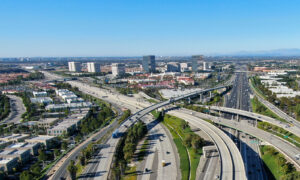 Ever since the world’s first electric traffic signal was installed in Cleveland 108 years ago, motorists have been wishing for more green lights.
Ever since the world’s first electric traffic signal was installed in Cleveland 108 years ago, motorists have been wishing for more green lights.
Irvine keeps getting them.
The city recently resynchronized 18 traffic lights along Main Street, upgrading Irvine’s 19 fully synchronized corridors. The city is in the process of upgrading an additional 31 traffic lights along Culver Drive this year.
“We’ve done studies on this corridor, and we’re seeing a 16% overall reduction in travel time,” says Jaimee Bourgeois, Irvine’s deputy director of transportation.
Irvine’s Master Plan created a unique, hierarchical street system (as opposed to a grid system) designed to keep traffic out of neighborhoods by using city-long corridors to connect residents to nearby jobs and amenities. By synchronizing more than 300 signals along these corridors, the city has eliminated nearly one-third of the stops a motorist would’ve encountered without synchronization.
Synchronization plan
Synchronization coordinates green lights over a series of intersections to maximize traffic flow.
Lights are synchronized for morning, midday and evening commutes. To work best, they may benefit one direction at morning peak and the other direction at evening peak.
Each light along the route is assigned the same cycle length, ranging from 110 to 200 seconds (reserved for peak conditions).
In the past, corridors that intersect the route might have different cycle lengths, which can cause delays. But Irvine recently completed a synchronization master plan to address that.
“We’ve come up with zones throughout the city where intersecting corridors will share a common signal length,” Bourgeois says. “That way, we can time the signals so that cars in both directions are more likely to get a green light.”
Traffic Management Center
The city manages all of its 378 signaled intersections from a Traffic Management Center, where a team of six full-time and two part-time staff monitor road conditions seven days a week, using a wall of TV monitors that resembles NASA’s Mission Control room.
“That’s what sets us apart from most other cities,” Bourgeois says.
Inside this control room, traffic engineers monitor work commutes, school zones, construction activities and special events and are able to adjust the timing of lights as traffic flow warrants.
The city is also testing a new “adaptive” traffic-light system that could fine-tune the timing of every light automatically in response to moment-by-moment traffic conditions.
“We’re continuing to move forward,” Bourgeois says.









